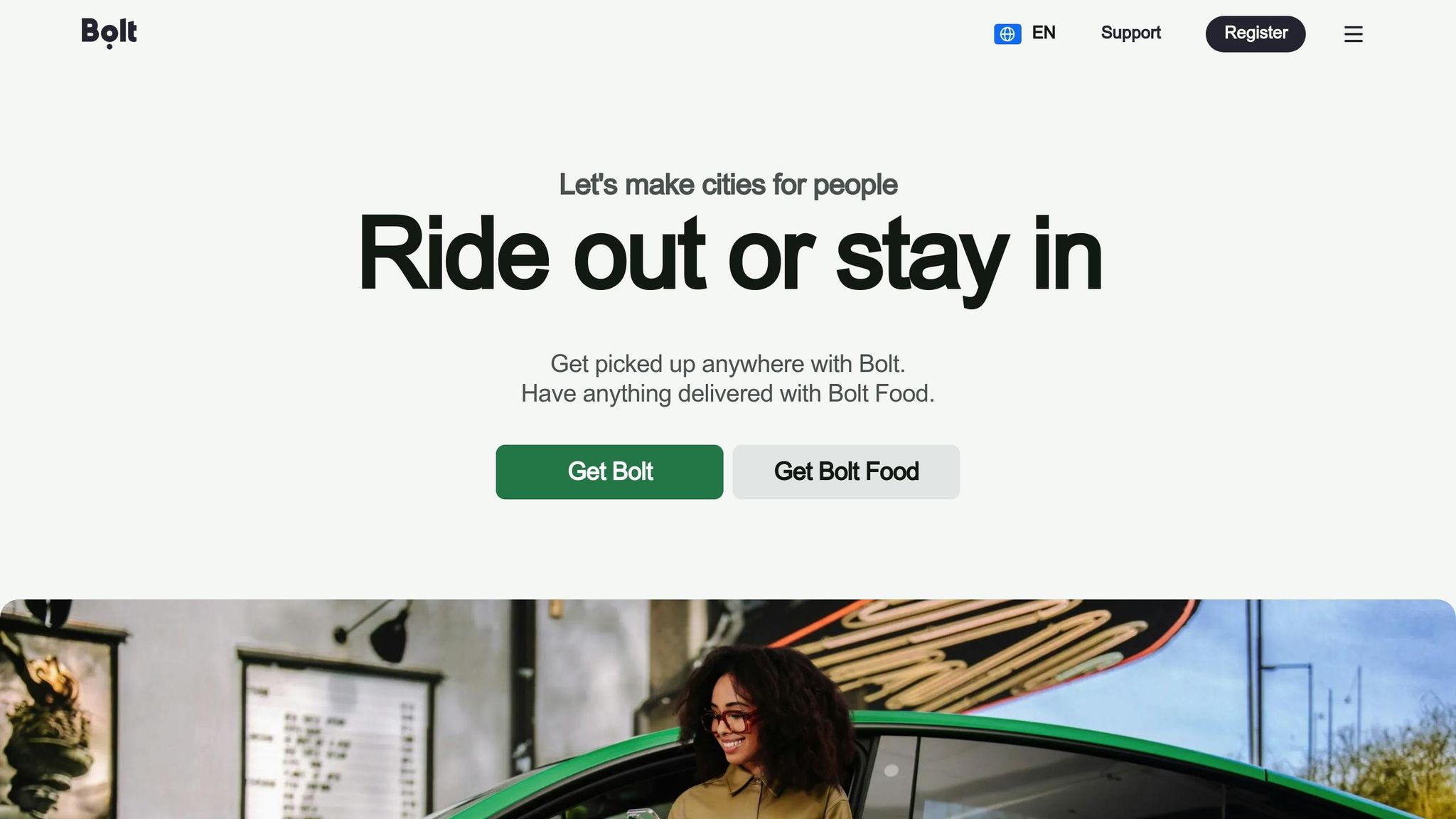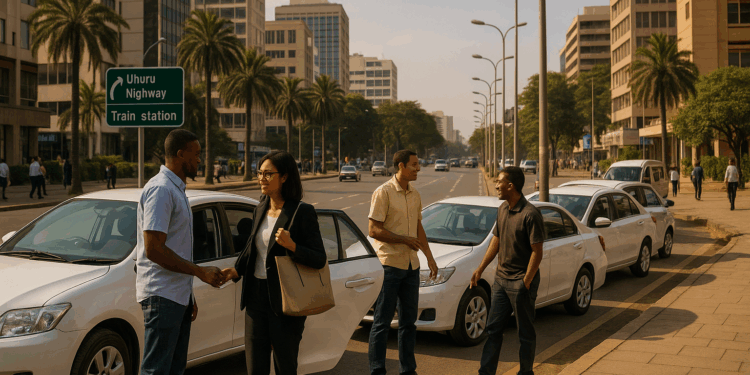Navigating Nairobi’s ride-sharing rules is crucial for drivers, operators, and riders. Here’s what you should know:
- Strict Regulations: Ride-sharing services in Nairobi are heavily regulated to ensure safety, compliance, and fairness. Drivers need proper licenses, while operators must meet safety and insurance standards.
- Key Agencies: The National Transport and Safety Authority (NTSA) handles vehicle licensing and driver certifications, while Nairobi City County oversees local permits and compliance.
- Licenses and Permits: Operators need a Transport Licensing Board (TLB) license and a Transport Network Operator (TNO) license for app-based services. Local permits from Nairobi County are mandatory.
- Fare Disputes: Minimum fares are set at KES180 ($1.40), but drivers argue it’s too low and propose higher rates to cover costs. Unresolved fare-setting issues persist.
- Safety Standards: Stricter rules require vehicle inspections, driver background checks, and compliance with new safety mandates. By January 2025, vehicles must be from 2017 or newer.
These regulations aim to balance safety, driver earnings, and service quality, creating a structured ride-sharing ecosystem in Nairobi.
Actioning a Safer Ride-Hailing Industry in Kenya with Bolt Kenya GM

Who Controls Ride-Sharing in Nairobi?
In Nairobi, multiple government agencies oversee the regulation of ride-sharing services. Understanding the role of each agency helps drivers, operators, and passengers navigate the system more effectively. Below is a breakdown of their responsibilities.
National Transport and Safety Authority (NTSA)

The National Transport and Safety Authority (NTSA) is the primary body regulating ride-sharing across Kenya, including Nairobi. It sets the rules for vehicle licensing, driver certification, and safety standards for all commercial transport services on public roads.
NTSA’s responsibilities include conducting vehicle inspections and performing driver background checks. These measures ensure that vehicles have the required commercial licenses and that drivers hold valid Public Service Vehicle (PSV) licenses. However, recent disagreements between NTSA regulations and local county rules have caused some tension.
Nairobi City County‘s Role
Locally, Nairobi City County manages permits, compliance, and enforcement for ride-sharing services within the city. The county government oversees all commercial motor vehicles operating in Nairobi.
To operate legally, ride-sharing vehicles must have a taxicab permit issued by the county. These permits are valid for one year and must be renewed annually. Moreover, ride-sharing services are required to operate under registered Transport SACCOs (Savings and Credit Cooperative Organizations) or companies that meet the county’s specific standards. Permit applications can only be submitted through these registered entities. The county’s Directorate also maintains a database of all registered permit holders to ensure proper oversight.
Data Protection and Privacy Rules
The Office of the Data Protection Commissioner is responsible for regulating how ride-sharing platforms handle personal data from both drivers and passengers. This includes overseeing the collection, storage, and use of sensitive information such as user registration details, trip histories, and payment records.
Platforms must obtain clear consent from users before collecting any personal data and are required to implement robust security measures to protect this information. Additionally, they must provide transparent privacy policies and offer users the ability to access, update, or delete their data. The commissioner investigates complaints related to data misuse and enforces penalties for violations of Kenya’s data protection laws.
License Requirements for Operators
If you’re operating in Nairobi, securing the right licenses and permits isn’t just a formality – it’s essential to keep your business running smoothly and legally. Here’s a breakdown of the key requirements you need to meet.
Operator License Requirements
First, you’ll need to register your business with Kenya’s Business Registration Service and ensure you’re compliant with tax regulations through the Kenya Revenue Authority (KRA). These are foundational steps to establish your business legally.
Next, transportation services require two critical permits. For commercial transport services, obtaining a Transport Licensing Board (TLB) license is a must. If you’re running an app-based transportation service, you’ll also need a Transport Network Operator (TNO) license – this permit is mandatory for all app-based platforms.
Additionally, you’ll need to work with Nairobi City County to secure local permits. These often include adhering to specific routes designated for Public Service Vehicles (PSVs), following regulations similar to those for traditional PSVs.
Failing to secure the proper permits can lead to severe consequences. For example, in February 2020, the National Transport and Safety Authority (NTSA) took action against Swvl, prosecuting its CEO and halting their operations in Nairobi. The issue? They were using a tour service license instead of the required permits.
Fares, Taxes, and Payment Rules
Having a good grasp of Nairobi’s ride-hailing fare structure is essential for both drivers and passengers.
How Fares Are Set
Ride-hailing companies like Uber, Bolt, and Faras calculate fares based on a combination of distance, time, and demand. As of August 2024, the minimum fare is set at KES180 ($1.40). However, many drivers argue that this amount no longer reflects the increasing operational costs and rising cost of living.
To address this, drivers are advocating for a minimum fare of KES300 ($2.33), which they say would cover the cost of 1 liter of fuel along with an additional KES100 ($0.78) for other expenses. For trips exceeding 3 kilometers, drivers suggest applying a 1.5× multiplier to the fare. In some cases, drivers have refused to accept passengers who are unwilling to pay these higher, unofficial rates. Supporting this stance, AA Kenya, a mobility solutions company, has recommended that ride-hailing services charge at least $0.26 (KES33) per kilometer to adequately cover vehicle maintenance costs.
In response to these concerns, the Ministry of Transport and the National Transport and Safety Authority (NTSA) have stepped in to mediate discussions between ride-hailing platforms and drivers’ associations. However, there are currently no official government-imposed fare limits or guidelines in place. These unresolved issues around fare-setting have a direct impact on drivers’ earnings, as explored below.
Driver Pay and Platform Fees
Drivers’ earnings are not only influenced by fare calculations but also by the platform fees and commission structures imposed by ride-hailing companies. These commission fees significantly cut into drivers’ income, adding to their dissatisfaction with what they see as inadequate base fares. This frustration has fueled ongoing disputes and protests.
Ride-hailing platforms like Uber and Bolt have issued warnings to drivers against charging fares outside of the app, stating that such practices violate community guidelines and could result in penalties, including account suspension.
Drivers are increasingly demanding a say in fare-setting, a call that has been amplified through recurring strikes and pricing disputes. For trips to high-demand locations like airports and railway stations, drivers have proposed fares ranging from KES1,000 ($7.75) to KES5,000, arguing that these routes require higher rates to account for longer distances and elevated operational costs.
sbb-itb-e5ed0ed
Safety Rules and Enforcement
In Nairobi, regulatory enforcement plays a key role in ensuring compliance with safety standards. A recent example is the introduction of the "Nairobi County Taxi Permit Regulations 2023", which has stirred significant debate. Many drivers argue that these regulations are not only unfair but also violate legal and constitutional principles.
Details about enforcement measures, penalties, and safety inspections will be covered in the next section.
What Drivers Need to Do
To keep things running smoothly on Nairobi’s ride-sharing platforms, drivers must follow the platform rules and maintain a good standing. Staying compliant not only protects your account but also ensures you deliver a high-quality service. Here’s what you should focus on daily and weekly:
Daily and Weekly Tasks for Drivers
Mike Neighbour emphasizes the importance of vigilance:
"Mind your account lest it gets blocked and you fail to enjoy the fare review."
David Muteru echoes this sentiment, highlighting the need for professionalism:
"Uber does not entertain any bad behaviour from any user of the Uber platform, be it riders or drivers. Keep it up."
Key points to remember include avoiding fare negotiations and treating every passenger with courtesy and respect. Sticking to these practices is essential for meeting Nairobi’s regulatory requirements and keeping your ride-sharing service active.
Conclusion: Following Ride-Sharing Rules in Nairobi
The ride-sharing regulations in Nairobi are designed to create a fair and efficient system for everyone involved. For drivers, the 18% commission cap ensures they keep more of their earnings, while the upcoming vehicle standards – requiring 2017-and-newer vehicles by January 2025 and 2018-and-newer by January 2026 – help maintain service quality and reliability across the city.
For riders, enhanced safety measures like selfie verification, in-app SOS features, and stricter licensing requirements for drivers and operators add multiple layers of protection. Simple steps like verifying driver identity and vehicle details before booking can further increase safety and peace of mind.
This regulatory framework balances driver welfare, rider safety, and platform viability. By capping commissions and encouraging higher safety standards, Nairobi strengthens its ride-sharing ecosystem, ensuring it serves the needs of its growing urban population.
Whether you’re a driver planning to upgrade your vehicle or a rider relying on these services for daily commutes, understanding and following these rules is essential. Together, these measures create a safer, more dependable transportation network tailored to Nairobi’s unique challenges and opportunities.
FAQs
What happens if ride-sharing operators in Nairobi don’t have the required licenses and permits?
Ride-sharing operators in Nairobi who skip out on obtaining the necessary licenses and permits could find themselves in hot water. They risk facing fines of up to 50 penalty points, a possible three-month jail term, or even further legal consequences.
Beyond the penalties, non-compliance can also result in operators having their services suspended or completely shut down. Meeting these legal requirements isn’t just about avoiding fines – it’s about keeping operations smooth and ensuring a safe, lawful experience for both drivers and passengers.
How do fare disputes between drivers and ride-sharing platforms affect the ride-sharing experience in Nairobi?
Fare disagreements between drivers and ride-sharing platforms in Nairobi can significantly shape the ride-sharing experience. These conflicts often arise as drivers push for higher fares to counter rising operational expenses, which can, in turn, lead to increased costs for riders. This shift might make the service less affordable for many users.
Beyond affordability, these disputes can result in driver dissatisfaction, strikes, or even fewer drivers on the road. Such scenarios often translate to longer wait times and reduced reliability for passengers. On top of that, ongoing friction between drivers and platforms can erode trust, potentially affecting the safety and overall convenience of ride-sharing for everyone involved.
What safety measures are in place to protect drivers and passengers in Nairobi’s ride-sharing services?
Nairobi has implemented ride-sharing regulations designed to prioritize safety for both passengers and drivers. One of the key measures is mandatory driver verification, which ensures all drivers pass strict background checks and meet licensing requirements. This step helps establish trust and accountability.
To further enhance safety, ride-sharing apps are equipped with in-app safety features, including GPS tracking and emergency assistance, offering real-time support during rides. Drivers must also complete professional training programs to improve their skills and stay informed about safety protocols.
For passengers, wearing safety belts is a must, and vehicles are required to meet specific maintenance standards to guarantee reliability and security. Together, these measures aim to create a safer, more dependable ride-sharing experience for everyone.
Related posts
- Ultimate Guide to Off-Road Safety in Kenya
- NTSA Roadworthiness Rules for Commercial Vehicles 2025
- Car prices in Nairobi 2025
- Car insurance costs in Kenya




